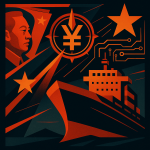Key Points
- Market surge & valuation: Cambricon (寒武纪) reclaimed the highest‑priced A‑share spot with shares near ¥1,480 per share and a market capitalization topping ¥600 billion RMB, implying a dynamic P/E of ~280x.
- Sharp financial recovery: Q3 2025 revenue was ¥1.727 billion RMB (up 1,332.5% YoY) with net profit ¥567 million RMB, marking its fourth straight profitable quarter; H1 revenue reached ¥2.881 billion RMB (up 4,347% YoY).
- Inference‑focused tech & software edge: Cambricon targets NPUs and the SiYuan (思元) family (e.g., SiYuan 590) for inference workloads, emphasizing software compatibility and operator‑level optimizations as its competitive differentiator versus GPU‑centric players.
- Concentration and supply risks: Revenue is highly concentrated—top five customers were 94.63% of sales in 2024 and the largest customer was ~¥930 million RMB (≈79.15%); manufacturing constraints and export controls remain key risks to scaling.

Cambricon’s share price surge and turnaround are getting attention across China’s AI‑chip market.
Since August 2025 its share price has repeatedly overtaken Kweichow Moutai (Guìzhōu Máotái 贵州茅台).
On November 6 it rose nearly 10% to ¥1,480 per share ($206 USD), reclaiming the title of the highest‑priced A‑share stock.
Quick snapshot: why investors are talking about Cambricon
Rapid revenue recovery and a multi‑quarter profit streak have dramatically changed investor sentiment.
The stock price volatility reflects both financials and the market’s hunger for a domestic AI‑chip success story.

Resume Captain
Your AI Career Toolkit:
- AI Resume Optimization
- Custom Cover Letters
- LinkedIn Profile Boost
- Interview Question Prep
- Salary Negotiation Agent

Recent financials: rapid revenue and profit recovery
In the company’s Q3 2025 report (released October 17), Cambricon posted revenue of ¥1.727 billion RMB ($239.9 million USD), up 1,332.5% year‑over‑year.
Net profit attributable to shareholders in Q3 2025 was ¥567 million RMB ($78.8 million USD).
That marked the fourth straight profitable quarter for the company.
Earlier in 2025 Cambricon reported a record six‑month result with first‑half revenue of ¥2.881 billion RMB ($400.1 million USD), an astonishing 4,347% year‑over‑year increase.
That first‑half result included net profit attributable to the parent company of ¥1.038 billion RMB ($144.2 million USD), a turnaround from prior losses.
After that report, Cambricon briefly closed at ¥1,587.91 per share ($220.5 USD) and surpassed Kweichow Moutai to become the most expensive A‑share by price.

From shareholder sell‑offs to a rebirth
Only two years earlier Cambricon’s outlook looked starkly different.
High R&D spending kept the company loss‑making after IPO.
By September 2023 six early shareholders had together sold about ¥6.8 billion RMB ($944.4 million USD) worth of shares, prompting media skepticism about the company’s future.
By 2024 losses had substantially narrowed, and in 2025 the market sent Cambricon’s valuation soaring.
As of late October its market capitalization topped ¥600 billion RMB (roughly $83.3 billion USD).
That valuation implied a dynamic P/E above 280x, far higher than NVIDIA’s ~48.7x, reflecting both strong growth expectations and the scarcity of listed Chinese firms with mature AI‑chip operations.

Find Top Talent on China's Leading Networks
- Post Across China's Job Sites from $299 / role, or
- Hire Our Recruiting Pros from $799 / role
- Qualified Candidate Bundles
- Lower Hiring Costs by 80%+
- Expert Team Since 2014
Your First Job Post

Different technical paths: NPU vs. GPU
Cambricon pursues neural processing units (NPUs) specialized for deep‑learning inference.
NVIDIA built its business on general‑purpose GPUs and a massive software ecosystem.
The two approaches are technically distinct but share a common playbook: dominate a narrow, fast‑growing segment, build software and ecosystem advantages, then expand market share.
NVIDIA’s founder and CEO Jensen Huang has praised early, targeted silicon efforts such as Google’s TPU (Tensor Processing Unit).
Cambricon’s founders — Chén Tiānshí (陈天石) and Chén Yúnjì (陈云霁) — came from the Institute of Computing Technology, Chinese Academy of Sciences (ICT, CAS 中国科学院计算技术研究所).
The founders helped pioneer neural‑network‑centric chip architectures in academic work widely cited by global researchers.

ExpatInvest China
Grow Your RMB in China:
- Invest Your RMB Locally
- Buy & Sell Online in CN¥
- No Lock-In Periods
- English Service & Data
- Start with Only ¥1,000

Academic roots: DianNao and DaDianNao
In 2014 the team’s papers “DianNao: A Small‑Footprint High‑Throughput Accelerator for Machine Learning” and “DaDianNao: A Machine‑Learning Supercomputer” won top awards at leading processor conferences.
Those papers proposed architectures for dedicated deep‑learning accelerators and demonstrated power and performance benefits over CPU and GPU prototypes.
The work was later cited by Google’s TPU team and others.
The academic foundation helped the founders transition from lab prototypes to commercial products.

Commercial strategy: IP licensing, systems, then full chips
Cambricon initially followed an IP‑licensing model similar to ARM.
Its first generation, the 1A core, was licensed into Huawei (Huáwéi 华为) Kirin 970 chipsets and shipped in the Mate 10 smartphone.
Huawei was an early major customer and gave Cambricon initial commercial validation.
In 2017–2018 IP licensing accounted for over 98% of revenue.
But the partnership with Huawei did not last.
When Huawei moved to its own DaVinci/Ascend architectures (e.g., Ascend 310/910) and in‑house AI modules, Cambricon’s licensing revenue collapsed.
IP and software revenue share dropped from 99.7% in 2018 to around 15.5% in 2019.
That pushed Cambricon to accelerate development of its own system‑and‑chip products and diversify revenue streams.

How Cambricon survived the cash squeeze
Cambricon’s R&D intensity has long been extreme, with R&D spending often exceeding 100% of revenue.
Long receivable cycles and concentrated customer orders strained cash flow.
In 2019 a major domestic smart‑compute cluster project backed by ICT and local government in Zhuhai’s Hengqin New Area became a key order stream and helped stabilize the company.
Cambricon listed on the Science and Technology Innovation Board (科创板) in 2020, benefiting from looser listing requirements for early‑stage tech firms.
The company also faced manufacturing and supply‑chain setbacks after being placed on a US export control list at the end of 2022.
That required suspending cooperation with foundry partners such as TSMC (Táijīdiàn 台积电), depressing shipment volumes and revenue through 2021–2023.
Annual revenue was around ¥729 million RMB ($101.3 million USD) in 2022.

Why software and compatibility mattered — and paid off
The global AI boom accelerated in two phases: model training and model inference.
Model training was driven by huge cloud budgets and dominated by high‑performance GPUs like NVIDIA H100/H200.
Model inference is where trained models are deployed widely and need efficient, inexpensive chips at cloud, edge and device scale.
Training chips were largely supplied by NVIDIA, leaving inference open to specialized NPUs.
A major turning point came around early 2025 when open, high‑quality inference models became more accessible.
For example, the open R1 model (released by DeepSeek) made top‑tier inference models available broadly — creating demand for inference‑focused silicon.
Cambricon positioned its product line toward inference and scaled inventory aggressively.
Inventory rose from below ¥100 million RMB to ¥1.773 billion RMB ($246.3 million USD) as the company prepared shipments of its SiYuan (思元) family.
The SiYuan family includes the SiYuan 590, a chip Cambricon says is comparable to NVIDIA’s A100 for certain inference workloads.
Clients and third‑party analysts cited in the press point to software compatibility and operator‑level optimization as Cambricon’s competitive edge.
Reportedly, Cambricon’s inference stack showed better out‑of‑the‑box support for certain mainstream models and some operator optimizations that compared favorably to competing domestic chips such as Huawei’s Kunlun chip (昇腾 / Kunlun) in specific workloads.
Cambricon has emphasized building a developer‑friendly toolchain and extensive software compatibility with mainstream AI frameworks.
That investment appears to be paying off in large, concentrated orders.

Customer concentration and rumors
Cambricon’s revenue remains concentrated: in 2024 the top five customers accounted for 94.63% of sales.
The largest single customer contributed ¥930 million RMB ($129.2 million USD), or roughly 79.15% of revenue that year.
Market rumors in March 2025 suggested ByteDance (Zìjié Tiàodòng 字节跳动) ordered 40,000 SiYuan 580 chips at ¥25,000 RMB each (¥25,000 RMB ≈ $3,472 USD).
The rumored deal value was about ¥1.0 billion RMB ($138.9 million USD).
ByteDance denied the specific rumor, but the speculation underscored how sensitive Cambricon’s prospects are to large, single customer commitments.

Capital, profitability and the road ahead
In 2025 Cambricon delivered its first full‑year turnaround and positive operating cash flow.
The company’s ¥3.985 billion RMB ($553.5 million USD) private placement plan was approved by the regulator in September.
Proceeds were earmarked for a large‑model‑oriented chip platform, a software‑platform project for large models, and working capital.
That capital cushion, plus improving margins and a stronger inference market, has materially improved Cambricon’s financial posture compared with two years ago.

How close is Cambricon to becoming “China’s NVIDIA”?
Short answer: very far — but the gap is narrowing in a narrowly defined sense.
-
Scale and breadth: NVIDIA’s scale is enormous with diversified product lines, software stacks and global developer adoption, and Cambricon is only a few years old commercially.
-
Technical approaches: NVIDIA scaled via general‑purpose GPUs and the vast CUDA ecosystem; Cambricon focuses on NPU architectures for inference and must rely on software compatibility and niche wins to expand.
-
Manufacturing constraints: Export‑control limits on foundry access have left most domestic chips around 7nm manufacturing by SMIC (Zhōngxīn Guójì 中芯国际), creating a structural performance gap versus the latest NVIDIA data‑center parts.
-
Domestic market opportunity: U.S. restrictions reduce availability of U.S. high‑end GPUs in China and create an addressable market for domestic suppliers to capture and scale into.
Cambricon is not NVIDIA today — in scale, ecosystem or product breadth.
But its turnaround, market timing around inference demand, and heavy investment in software and toolchains could let a domestic AI‑chip vendor become a meaningful alternative in select segments of the market.

What to watch next — checklist for investors, founders and tech leaders
-
Order diversification: Can Cambricon reduce concentration risk by winning multiple large cloud, internet and enterprise customers?
-
Manufacturing capacity: How quickly can SMIC (Zhōngxīn Guójì 中芯国际) scale 7nm+ output, and can Cambricon mitigate process gaps through architecture and software?
-
Software and ecosystem: Sustained investment in compilers, operator libraries and compatibility with mainstream model ecosystems will determine developer adoption.
-
Regulatory and export dynamics: Global trade controls and domestic industrial policy will continue to shape supply chains and addressable markets.

Bottom line
Cambricon’s story is still unfolding.
It began with academic roots and IP licensing, went through a painful near‑failure period, and then staged a rapid commercial rebound driven by an inference‑focused market and heavy software investment.
Whether the company can translate momentum into a broad and sustainable alternative to NVIDIA remains an open question.
For now, Cambricon has moved from survival to relevance, and it is one of the most closely watched names in China’s AI‑chip ecosystem — keep watching Cambricon.

References
- 寒武纪股价再超茅台,它距离成为英伟达有多远? – 第一财经
- Cambricon 2024 Annual Report – Cambricon Technologies (寒武纪)
- Cambricon and Chinese AI chipmakers: market coverage and analysis – Financial Times




![The First HarmonyOS PC is Here: A Game-Changer for Domestic Operating Systems and the Global Tech Scene [FreshFromChina]](https://freshfromchina.com/wp-content/uploads/2025/05/the-first-harmonyos-pc-is-here-a-game-changer-for-domestic-operating-systems-and-the-global-tech-scene.png____FreshFromChina-150x150.png)